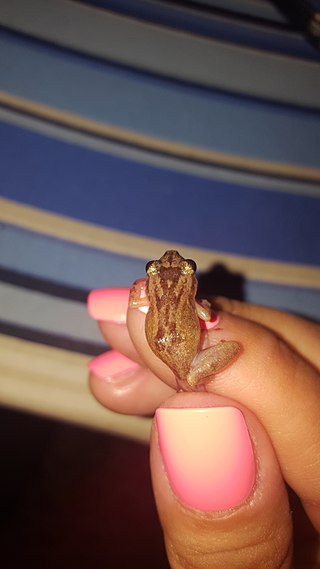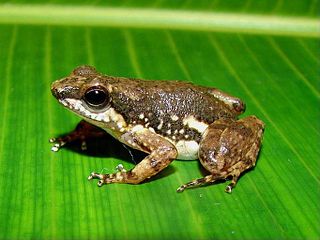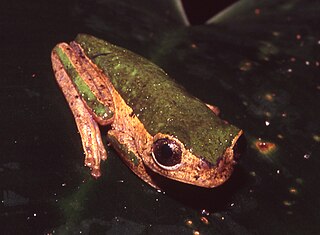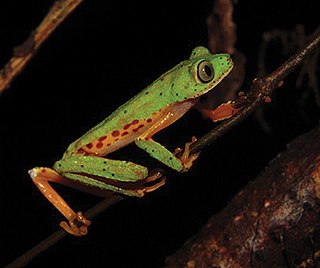
The whistling coquí, Cochran's treefrog, or Cochran's robber frog is a species of frog native to Puerto Rico, the US Virgin Islands, and the British Virgin Islands. This nocturnal insectivore is also referred to as the coquí pitito in Puerto Rico. Their distinctive song is a single, rising whistle, which is repeated and followed by three clicking sounds.

Nymphargus grandisonae is a species of frog in the family Centrolenidae. It is found in Andes of Colombia and Ecuador. Its natural habitat is tropical moist montane forest ; larvae develop in streams and still-water pools. Its habitat is threatened by habitat loss, introduced fish, and agricultural pollution, but it is still a common species not considered threatened by the IUCN.

Colostethus inguinalis is a species of frog in the family Dendrobatidae. It is endemic to northwestern and northcentral Colombia. Its vernacular name is common rocket frog, although this name can also refer to Colostethus panamansis that until 2004 was considered a junior synonym of Colostethus inguinalis. Much of the older literature on Colostethus inguinalis is actually about Colostethus panamansis.

Colostethus panamansis, also known as the Panama rocket frog or (ambiguously) common rocket frog, is a species of poison dart frog. It is found in northwestern Colombia and Panama. It is one of the best studied poison dart frogs; however, until 2004 Colostethus panamansis was considered a synonym of Colostethus inguinalis, and consequently the older literature uses that name.

Allobates talamancae is a species of frog in the family Aromobatidae. It is found in northwestern Ecuador, western Colombia, Panama, Costa Rica, and southern Nicaragua.
The Pilalo tree frog is a species of frog in the family Hylidae endemic to Ecuador. Its natural habitats are subtropical or tropical moist montane forests and rivers. It has been observed between 2300 and 2600 meters above sea level. It is threatened by habitat loss.
Phasmahyla exilis, the mottled leaf frog, is a species of frog in the subfamily Phyllomedusinae. It is endemic to Brazil. It has been observed between 200 and 900 meters above sea level.
Phasmahyla guttata, the spotted leaf frog, is a species of frog in the subfamily Phyllomedusinae. It is endemic to Brazil. It lives in forests and near the edges of forests but not outside forests. It has been observed between 50 and 1200 meters above sea level.
Phasmahyla jandaia is a species of frog in the subfamily Phyllomedusinae. It is endemic to Brazil, where it has only been observed more than 1000 meters above sea level.

Phyllomedusa camba or the black-eyed monkey frog is a species of frog in the subfamily Phyllomedusinae. It is found in Bolivia, Brazil, and Peru. It has been observed between 280 and 1000 meters above sea level.

Pithecopus palliatus is a species of frog in the subfamily Phyllomedusinae. It is found in Bolivia, Brazil, Ecuador, Peru, and possibly Colombia. Its natural habitats are subtropical or tropical moist lowland forests and intermittent freshwater marshes. It is threatened by habitat loss. It has been observed between 100 and 400 meters above sea level.

Phyllomedusa tarsius, the brownbelly leaf frog or tarsier leaf frog, is a species of frog in the subfamily Phyllomedusinae. It is found in Brazil, Colombia, Ecuador, Peru, and Venezuela, and possibly Bolivia and Guyana. This frog has been observed as high as 800 meters above sea level.

Hyperolius molleri is a species of frog in the family Hyperoliidae. It is endemic to São Tomé Island. Records from Príncipe now refer to Hyperolius drewesi, described as a distinct species in 2016.

Pseudophilautus decoris, commonly known as the elegant shrub frog, is a species of frogs in the family Rhacophoridae. It is endemic to Sri Lanka.

Taruga longinasus is a species of frog in the family Rhacophoridae. It is endemic to Sri Lanka. It has been observed between 150 and 1300 m above sea level.

Zhangixalus arboreus, also known as the forest green tree frog and Kinugasa flying frog, is a species of frog in the family Rhacophoridae endemic to Japan, where it has been observed on Honshu island, as high as 2000 meters above sea level.

Phasmahyla spectabilis is a species of frog in the subfamily Phyllomedusinae. It is endemic to Brazil and known from the north-eastern Minas Gerais and adjacent southern Bahia. It occurs in fragments of Atlantic Forest at elevations of about 800 m (2,600 ft) above sea level.People have seen it as high as 850 meters above sea level.

Phasmahyla timbo is a species of frog in the subfamily Phyllomedusinae. It is endemic to Brazil. Scientists know it exclusively from Serra do Timbó. People have seen it between 800 and 900 meters above sea level.
Phasmahyla cruzi is a species of frog in the subfamily Phyllomedusinae. It is endemic to Brazil and solely known from the vicinity of its type locality, Rio das Pedras Reserve in the municipality of Mangaratiba, Rio de Janeiro state. The range extends into the adjacent Paraty municipality. This species is named for Carlos Alberto Gonçalves da Cruz, Brazilian herpetologist. The common name Mangaratiba tree frog has been proposed for it.
Phasmahyla lisbella is a species of treefrog in the subfamily Phyllomedusinae, endemic to Brazil. Scientists know it only from the type locality: Fazenda Ventania in Área de Protecão Ambiental Ventania. It has been observed between 536 and 1,000 meters above sea level.















